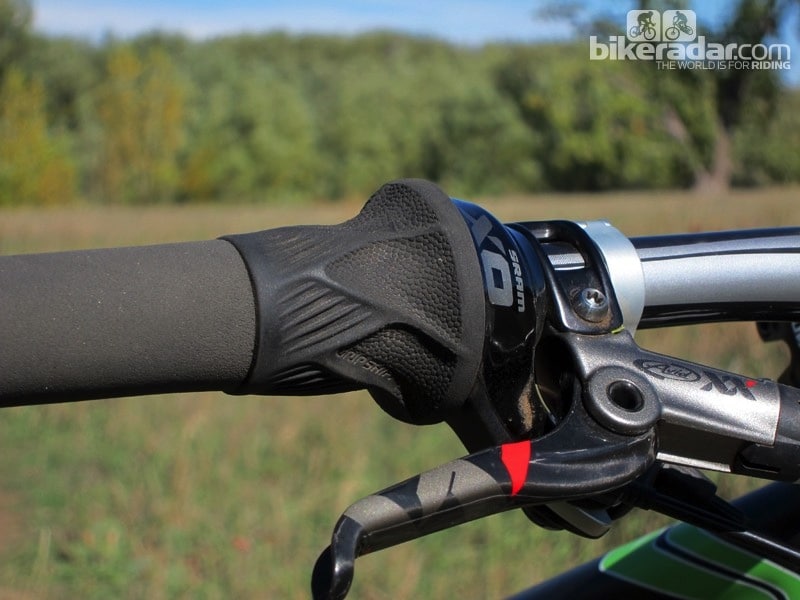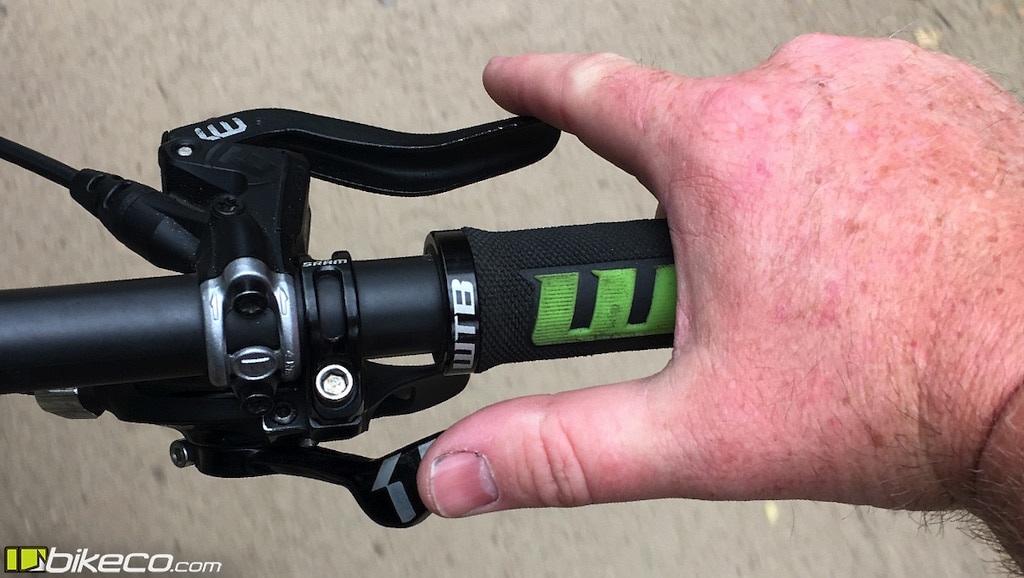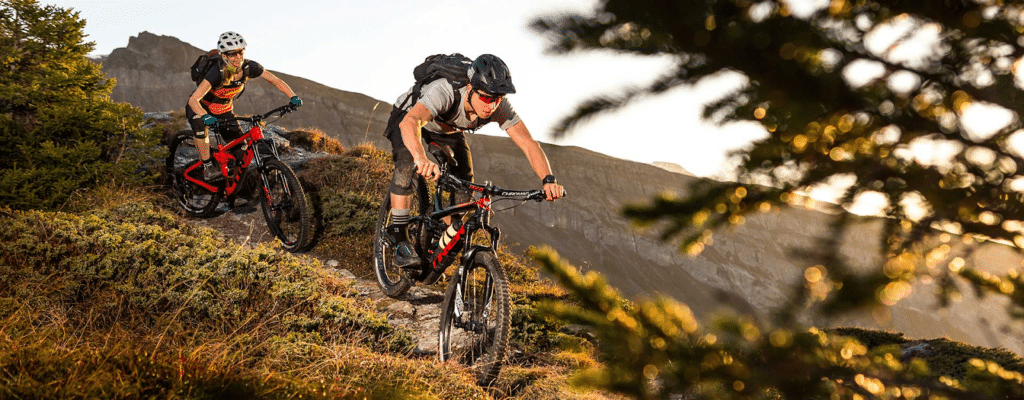How to Choose Mountain Bike Grip Shifters
Mountain bike grip shifters allow you to select higher or lower gears as needed during your rides with the twist of your wrist. We’ll discuss how to choose mountain bike grip shifters so you can shred any trail you have your heart set on.
To choose a mountain bike grip shifter, consider how easy it is to install the shifter, the type of terrain you’re riding on, the range of gears available on the shifter, the grip shifter material, shifting velocity, the price, and how compatible it is with the bike.
Grip shifters come with a number of speed options and are an affordable and easy upgrade to make to your mountain bike. Let’s get into this topic!
What Is a Mountain Bike Grip Shifter?

A mountain bike grip shifter has markings to indicate what gear your bike is currently in, and can easily twist to change gears across various levels during an off-road ride. In this article from IEEE Xplore titled, “Gearing Up for Mountain Biking,” the gear system is examined and the author suggests how to optimally adjust the available gears for a smoother ride.
A mountain bike grip shifter is also known as a twist-shift and is a simple mechanism for gearing up or down during a ride. The grip shifter has calibration marks to indicate the current gear that’s selected.
Types of Mountain Bike Shifters
There are numerous kinds of mountain bike shifters available, so it is important to research the pros and cons of each in order to make the right choice for your mountain bike. These factors could include price, compatibility, and functionality as well as your riding habits when you shift gears. Choosing the right gear shifter for your riding style will make all the difference when forming good riding habits.
Different types of mountain bike shifters include thumb shifters, twist shifters, trigger shifters, and electronic shifters. Thumb shifters can be driven by a thumb and index finger. Twist shifters require a twisting motion of the hand to change gears. Trigger shifters are designed for fast gear changes, especially useful for landing jumps and drops. Electronic shifters use wifi and battery power to change gears instead of cables.
Twist Shifters
Twist shifters, or grip shifters, are placed over the handlebar and can be used by simply rotating the shifter forward or backward in order to increase or decrease gears respectively. They are usually favored by riders because they do not need to take their hands off the handlebars in order to change gears. Grip shifters are also perfect for riders who use heavy gloves. You don’t need to fit your glove into a small hold in order to shift gears when using grip shifters. Here’s an example of mountain bike twist gear shifters that are easy to install and have a comfortable rubber grip.
Trigger Shifters
Trigger shifters are also known as rapid-fire shifters. The trigger is positioned below the handlebars for swift and smooth gear changing while riding. Riders can use their thumb to increase the gears and their index finger to lower them. The gears are precise and there is no danger of the rider unintentionally or accidentally switching gears.
If your shifter isn’t selecting the appropriate gear with ease it may be getting stuck. Read our article on how to fix a gear shifter that is stuck for helpful tips to remedy this problem.

Thumb Shifters
Thumb shifters are a type of trigger shifter. These shifters are designed to position on the handles in a way that allows the user to gear up and down by using the thumb. By using only your thumbs, you can continue to hold on to the brakes using your index fingers. This gives you some more control over your bike even while changing gears. This thumb gear shifter from Amazon makes it easy to change gears without causing hand and wrist fatigue during long bike rides.
Electronic Shifters
These shifters require no cables and are powered by a battery. This video explains how an electronic gear shifter works and where the battery is often installed on the bike frame. A wireless motor is installed on the derailleur to receive a signal from the shift levers, which then moves the chain up or down the chain sprockets to increase or decrease the gear and speed.
Below is a summary of the different types of mountain bike shifters with their pros and cons:
| Type of Mountain Bike Shifter | Pros | Cons | Amazon Product Example (Link) | Price Range |
| Twist Shifters or Grip Shifters | Allows you to switch 1 gear quickly without removing your hand from the grip | You might accidentally shift when going over a bump -- you can avoid this by placing your fingers appropriately on bumpy rides. | Sram MRX Comp Twist Shifter | ~$15-$25 |
| Trigger Shifters | Allow you to click a button to change gears. Easier to read which gear you are currently on. | Can be a hassle to use if you constantly need to change gears. Requires your thumb and index finger to use, so they won’t be on your grip or the brakes. Also, your fingers might tire out if you use trigger shifters a lot. | Sram GX Eagle 12-Speed Trigger Shifter | ~$40-$50 |
| Thumb Shifters | Similar to trigger shifters but only require you to use thumbs. | Takes some time to get used to which shifter to click to gear up or down. | Shimano Tourney Thumb Shifters | ~$20-$30 |
| Electronic Shifters | Trigger shifters that use wireless transmission and motors instead of cables. | Can be expensive. | Shimano Ultegra Di2 ST-R8050 11-Speed Shifters | ~$350 |
Whichever grip you choose, make sure you know where to hold mountain bike grips to maintain proper posture to help keep your back healthy too. Additionally, you may want to learn more about the difference between a mountain bike trigger shifter vs. a grip shifter. So be sure to read that article too.
Important Criteria for Choosing Mountain Bike Grip Shifters
Choosing a grip shifter for your mountain bike is a far more important decision than you probably realize. This article in Issue 9 of The Physician and Sportsmedicine Journal titled, “Shifting into Wrist Pain,” discusses how a rider experienced wrist pain when shifting gears while riding, and how properly installed and ergonomically designed gear shifters can assist in preventing these types of mountain bike related injuries.
Choose mountain bike gear shifters that are compatible with the bike gear shifting range, easy to install, simple to use on any terrain, and meet shifting velocity needs. Also consider the price of the gear shifter and the material it’s made of.

1. Is It Compatible With Your Bike?
Grip shifter compatibility is probably the first aspect you need to consider, since not every shifter that you can buy will necessarily work well with your mountain bike.
Compatibility depends on several factors including the brand of the mountain bike and derailleur, and other components of your bike.
Some brands of mountain bike components are compatible with others. But installing parts or components from a variety of different brands on your bike could result in complicated maintenance because of their incompatibility.
To check whether the grip shifter is compatible with your bike, read the user guide.
You might also be interested in adding drop bars to your bike. Before you do, be sure to check out our related article explaining what are mountain bike drop bars and why you need them. Then you can take it one step further to see if your drop bars might be compatible with the grip shifter you choose.
2. How Easy It Is to Install
Thumb, twist, and trigger shifters can easily be attached to the handlebar and do not need to be installed by a professional. You might need some help to thread the shifting cables but we’re sure you can figure it out!
Electronic shifters tend to require a professional and will therefore be slightly more expensive. Sometimes it's easier to install grip shifters when you know how to take them off. That being said, be sure to take a look at our step-by-step guide explaining how to remove mountain bike grip shifters for more information.
3. Type of Terrain and Weather When You’re Riding
The type of terrain that you plan on riding your bike on also plays an important role in deciding what kind of grip shifter you choose and this is because different terrains call for different kinds and speeds of gears.
If you’re riding on rocky terrain and need to hold on to your brakes most of the time, choose grip shifters. Thumb shifters are a great alternative but take some practice to learn and require you to remove your thumb from the grip in order to use them. Grip shifters are superior to trigger shifters when using heavy gloves since you don’t need to fit your thick gloves and fingers into small holds.
For commuting, city riding, and minor hills, trigger shifters (which need your thumb and index finger) are nice because they tell you which gear you’re on and how much faster you could go.
We aren’t fans of electronic shifters. They’re more gimmicky and less durable than the mechanical shifters like trigger and twist shifters. You’ll need to check the battery on your shifters every once in a while so you aren’t stranded with a bike that’s unable to shift gears during a long ride.

4. Range of Shifting Required for Your Rides
The range of shifting essentially refers to how much you are going to increase or decrease your gears and speed as you ride, and how often. This could either depend on the type of terrain you are riding on, traffic or personal preferences.
If you are in the city or on mild-moderate hills, you may find it comfortable to use a larger gear range. Trigger shifters like this one and electronic shifters give you precise control over your gear and you can easily see which gear you are on.
Twist shifters allow you to change up or down one gear with a small twist. For larger changes you need to take your hand off the brake. If you expect your ride to require large gear changes, in quick succession, get thumb shifters instead so that you don’t need to take your hands off the brakes.
5. Grip Shifter Material
Previously we’ve discussed how to choose mountain bike grips for numbness. In this article we discuss how you should choose grips that maximize friction and don’t need you to hold on tight so that the ulnar nerve doesn’t stay compressed for long periods of time.
The same concept applies to grip shifters as well. When choosing twist shifters, maximize the tackiness of the twist grip. It may not be as durable since tacky materials tend to degrade faster, but they will provide more friction.
Also, choose twist shifters with some padding and thickness so they are easy to hold on to and absorb vibration from the bike. Read our article on tips and tricks for determining the grip size you need for more information.
The materials used in trigger shifters don’t matter as much for your grip, so they can be plastics or metals. However, if you plan on riding in the rain a lot, plastic might fare better against the water.
6. Shifting Velocity
This refers to the speed at which you can shift from one gear to the next.
Do you need to rapidly transition through gears? Do you need to quickly slow down or speed up? Choose gear shifters with shifting velocity that’s appropriate to your terrain. We haven’t found user guides that publish the shifting velocity, so you may need to just buy and try things out.
7. Price
Thumb shifters and grip shifters are the cheapest ones to both install and purchase. Trigger shifters are next in line because they are moderately priced and require the cables to be configured slightly differently compared to thumb shifters. Electronic shifters are the most expensive and require professional installation which can be pricey.
You might also be wondering what type of mountain bike insurance providers and coverages are out there. Make sure to read our related article for more information.
Summary of How to Choose Grip Shifters
Determining a gear shifter's compatibility with your bike is the most important aspect to consider. Most types of gear shifters are relatively easy to install—except for the electronic shifters, which need professional installation. While you’re busy with changing your gear shift it might also be a good idea to examine your handlebar grips and replace them if they are worn out. Check out our guide to mountain bike grip sizes to make sure you buy the right replacements. You can also read our article on mountain bike grip installation for a step-by-step guide.
| Type of Rider | Recommended Shifter | Why | Amazon Product Example | Price |
| Beginner to Intermediate Mountain Bikers | Trigger or twist shifters | Twist shifters are great for all riders. Trigger shifters are fun to use so beginners and intermediates like them. However, they require 2 fingers for operation so they aren’t ideal for challenging terrain or rides. | Sram GX Eagle 12-Speed Trigger Shifter | ~$45 |
| Intermediate to Advanced Mountain Bikers | Twist shifters or Thumb shifters | Once again, twist shifters / grip shifters are great for all riders. Thumb shifters are a good alternative since they still allow you to keep hands on breaks while only needing 1 finger for operation. | Sram MRX Comp Twist Shifter | ~$25 |
